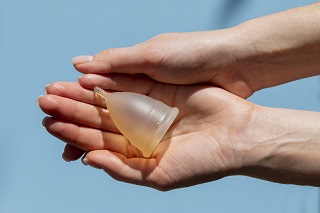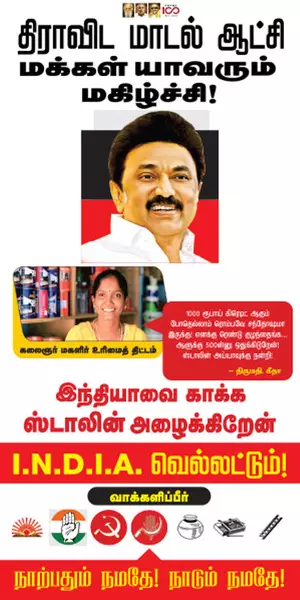
Menstrual cups are cheap, safe, user-friendly, but Indian women shun them; here's why
Of the 77.6 per cent of Indian women in the menstruating age group, only a minuscule 0.3 per cent use menstrual cups during periods; experts say the low usage is due to apprehensions and lack of awareness about the feminine hygiene product

Jyotsana, 22, suffers from menorrhagia. Her period is painful, with heavy bleeding. The frequent need to change pads makes those five-six days of the month all the more difficult for her. Yet, Jyotsana will not move to menstrual cups, which will require far fewer trips to the washroom.
A study published in The Lancet more or less corroborates this. The study reveals that menstrual cups are better, safer and more environment-friendly alternatives to sanitary pads and tampons. Despite this, a large number of Indian women continue to use sanitary napkins for menstrual protection.
According to data from the National Family Health Survey (NFHS-5), of the 77.6 per cent of Indian women who use hygienic methods of menstrual protection, 64.4 per cent aged 15-24 years use sanitary napkins while 49.6 per cent use cloth, 15 per cent locally prepared napkins and 1.7 per cent tampons. Only a minuscule 0.3 per cent use menstrual cups.
What is a menstrual cup?
A feminine hygiene product, the menstrual cup is a small, funnel-like and flexible cup, made of silicon or rubber. It can be inserted into the vagina to collect period blood and discharge.
Also Read: Menstrual cups: Why India is so uncomfortable with this bloody brilliant idea
Unlike tampons and sanitary napkins, menstrual cups are reusable. An eco-friendly alternative to pads and tampons, once inserted, a menstrual cup can hold blood up to 12 hours, thus sparing one of the worries of changing pads and tampons at regular intervals.
Even though the menstrual cup was first introduced in the US in the 1980s, it is still a newbie across the world.
Low levels of awareness
Experts say sheer lack of awareness and hesitancy among women to use the cup are major reasons behind its low popularity in India.
Disha Sridhar, obstetrician, gynecologist, hormone expert and founder of truhealing.com, vouches for menstrual cups. “One of the best things about a menstrual cup is that it’s made of medical-grade silicone, which is non-toxic and eco-friendly. Tampons, on the other hand, are made of toxic substances and have added fragrances. Sanitary pads contain chemicals like dioxin, irritants and allergens. Long exposure to these chemicals, may lead to various infections and even cancer later in life. There is also the toxic shock syndrome associated with tampons,” she told The Federal.
Disha, who personally prefers to use menstrual cups, believes that cups save a lot of money as a single unit can be used for five to 10 years.
However, it takes time to get used to the product.
“You get comfortable with it once you start using it. One thing that really works for me is that you can see your blood and analyse your flow through a menstrual cup. You do not get to analyse your period flow if you use a pad. However, I have observed that most women do not know much about their bodies or do not wish to learn about them. They are not very comfortable with their own secretions. I believe it takes knowing your own body and its anatomy for one to use menstrual cups. It’s basically trial and error at play,” she said.
Also Read: Kerala’s Kumbalangi to be first sanitary napkin-free village in India
Fears, taboos around a ‘foreign object’
According to the Lancet study, although there are 199 brands of menstrual cups available across 99 countries, awareness is still low.
Sarita Chaube, a gynaecologist at Sri Ganga Ram Hospital, Delhi, admitted that despite being a doctor herself, she has limited knowledge about menstrual cups and their benefits. She, however, raised a pertinent concern that most women who dread the menstrual cup share – the very prospect of inserting a foreign object into one’s vagina.
“I feel it’s the lack of knowledge which keeps women from using menstrual cups, and the feeling of some big foreign cup-like thing in the vagina also acts as a turn-off,” she said.
Most women contacted by The Federal preferred using pads over menstrual cups.
Monika Vohra, 45, didn’t know what a menstrual cup was. But the concept piqued her interest, with her questions to this reporter ranging from – “How does one use it?”, “Is it safe to use?” to “Where can one buy it?”
Twenty-five-year-old Presha Malhotra was worried the cup might not hold still once inserted into the vagina. “What if it gets lost inside and doesn’t stay in place? What would I do then? Would I have to go under the knife to get it removed?” asked Presha, giving voice to her concerns.
Also read: Taboos and social norms surrounding menstruation: A pain for women
Presha said her hesitancy stems from the fact that she has never seen her family members use menstrual cups. Her mother, grandmother and all the other women in her life have always used sanitary pads.
“Many people don’t even know about menstrual cups, and can you blame them for it? There aren’t enough advertisements to promote menstrual cups. Whereas, there’re so many ads to promote pads,” she said.
Hesitancy among mothers
Mothers are also hesitant in letting their adolescent girls use menstrual cups. L Pragna Shekar, Fundraising Manager at Uninhibited, an organisation which works towards ending shame and stigma around periods, talks about the reason behind this. “They are mostly concerned about their daughters using menstrual cups because of the fear that the hymen may break before their marriage. There’s the whole virginity myth,” she said.
Pragna said there shouldn’t be a problem as long as the teenager herself is comfortable with an insertable product, and is not forced to use it. “It should never hurt while inserting. In case it hurts, one should contact her gynecologist. For those who fear their hymen might break, it is important to know that the hymen tissue is actually stretchy and flexible, which means it does not necessarily tear with penetration. In many cases, some tearing or stretching occurs over time from tampons, cups, gynecologic exams or vigorous exercise,” she said.
End of the day, it is all about educating yourself and understanding what your body needs, to make an informed decision, believes Pragna.
“A woman’s worth should not be dictated by her virginity or the status of her hymen. Hymens can stretch/break due to many reasons. It’s not only limited to having sex,” Chainani added.
Perks of using a menstrual cup
Menstrual cups vary in size, colour and material used. An individual can choose a suitable cup, or seek the help of a gynaecologist for the same. Cups can hold twice as much fluid as sanitary pads and tampons. This makes them extremely useful on days of heavy flow.
“Four studies made a direct comparison between menstrual cups and usual products for the main outcome of leakage and reported leakage was similar or lower for menstrual cups than for disposable pads or tampons,” said a study published in The Lancet, titled ‘Menstrual cup use, leakage, acceptability, safety, and availability: a systematic review and meta-analysis’.
Menstrual cups, thus, also help one maintain hygiene.
One can wear a menstrual cup for up to 12 hours. The user can remove the cup at any time, dispose the menstrual blood and insert the cup again. After the periods are over, the cup can be sterilised with boiling water and kept aside for the next month.
Using cups, however, can become a problem for those who shudder at the sight of blood.
Tanya Sharma, 19, gets nauseous at the sight of blood. She prefers menstrual pads as they soak up the blood. “I can’t even stand someone getting a scratch. How can I handle the sight of blood accumulated inside a cup? So, I prefer pads,” she said.
Ritika Singhal, 21, seems to differ. She has been using menstrual cups for a while now, and is accustomed to the product She feels cups are good for both the body as well as the environment.
Also watch: COVID vaccine affecting menstruation cycle?
“Cups are also better at collecting blood than pads and tampons. There aren’t any harmful chemicals involved in their making, they are sustainable and cost less money. One just has to use them for a while to get accustomed,” she said.
Be aware, save the Earth
Every year, more than 20 billion disposable feminine hygiene products are dumped in landfills or flushed down the toilet. This can be prevented through the use of menstrual cups, with each cup having a lifespan of up to 12 years. This calls for the creation of awareness among women on the usage of menstrual cups, starting from the school level.
To enable girl students to make a safe and right choice, schools can hold sessions on menstrual health and hygiene.
Women can also book sessions with their gynaecologists to know more on the subject, understand their bodies, and what suits them best. They can learn about the pros and cons of each product (pads, cups and tampons) and how to use a particular product.





